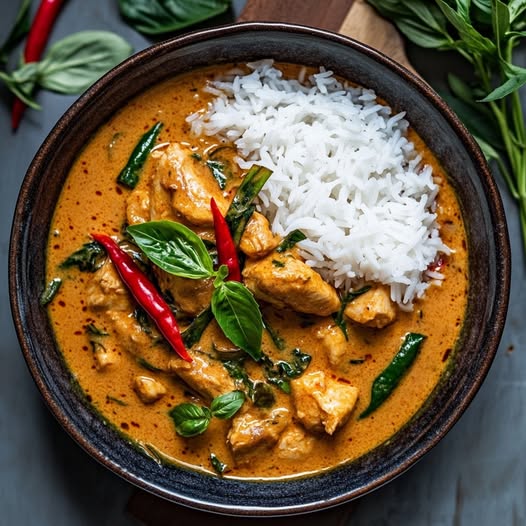
Why This Panang Chicken Curry Will Make Your Weeknights Magical
There’s something about the aroma of a bubbling pot of Panang Chicken Curry that instantly transports me back to my first trip to Thailand. I remember sitting at a tiny street food stall in Bangkok, where a kind vendor handed me a plate of this creamy, spicy curry. It was love at first bite! When I got home, I spent weeks perfecting this recipe in my own kitchen. Now, it’s become a go-to dish for busy evenings when I want something comforting yet exotic. Best of all? You can whip it up in just 30 minutes!
A Little History Behind Panang Chicken Curry
Panang Curry is a traditional Thai dish with roots in southern Thailand. Its name comes from the word “Penang,” which some believe refers to a spice blend used in the curry paste. Unlike other Thai curries, Panang Curry has a thicker, creamier sauce and a rich nutty flavor thanks to the addition of peanut butter. Traditionally, it’s served with beef, but chicken is now more common, especially in home kitchens. Over time, variations have popped up worldwide, but the heart of the dish remains—spicy, savory, and oh-so-satisfying.
Why You’ll Fall Head Over Heels for This Recipe
This Panang Chicken Curry is a crowd-pleaser for so many reasons. First, it’s incredibly flavorful without being complicated. The pungent curry paste, creamy coconut milk, and fragrant kaffir lime leaves create layers of taste that dance on your tongue. Second, it’s easy enough for beginners but sophisticated enough to impress guests. And third, it’s quick! On hectic weeknights, you can have dinner on the table faster than it would take to order takeout.
When to Serve This Dish: Perfect Occasions
Whether you’re hosting a casual dinner party or simply feeding your family after a long day, this curry fits the bill. It’s great for themed nights like “Taste of Thailand” or even as a cozy meal during cold weather. I also love making it for potlucks because it’s always a hit. Plus, leftovers taste even better the next day, so it’s perfect for meal prep too!
Ingredients: What You’ll Need
- 2 tablespoons of oil (coconut or vegetable)
- 3–4 tablespoons of prepared Panang curry paste
- 1 can (400 ml) of full-fat, unsweetened coconut milk, divided
- 4 boneless, skinless chicken thighs, sliced against the grain (~900 g)
- 1 tablespoon of palm sugar, coconut sugar, brown sugar, or turbinado
- 2 tablespoons of fish sauce (adjust to taste)
- 1 red bell pepper, thinly sliced
- 6 kaffir lime leaves, lightly crushed by hand
- 1 cup of snow peas (optional)
- 10 Thai basil leaves (or Italian basil as a substitute), plus extra for garnish
- 3 tablespoons of natural peanut butter
- 4 additional kaffir lime leaves, finely sliced (optional for garnish)
Substitution Options: Flexibility in the Kitchen
If you don’t have access to certain ingredients, no worries! Here are some swaps:
- Kaffir lime leaves: Use grated zest of regular lime if unavailable.
- Fish sauce: Swap with soy sauce or tamari for a vegetarian option.
- Thai basil: Regular basil works fine, though the flavor will differ slightly.
- Peanut butter: Almond butter is a good alternative for nut allergies.
Step 1: Toasting the Curry Paste
Heat the oil in a large skillet over medium heat until shimmering. Add the curry paste and cook, stirring frequently, until it becomes fragrant and darkens slightly, about 4–5 minutes. This step is crucial—it releases the essential oils in the paste, intensifying the flavors. Imagine the smell of toasted spices mingling with garlic and chilies; it’s pure magic! Pro tip: Don’t rush this part; patience here pays off in spades.
Step 2: Building the Sauce Base
Once the curry paste is toasted, pour in 1/4 of the coconut milk. Stir constantly until the mixture thickens into a smooth, glossy paste, around 1 minute. Next, add the chicken pieces, coating them evenly in the sauce. Cook for another minute before adding half of the remaining coconut milk. The sauce should start looking luscious and velvety, promising a decadent meal ahead.
Step 3: Adding Vegetables and Seasonings
Toss in the sugar, fish sauce, red bell pepper, and whole kaffir lime leaves. Let everything simmer gently, stirring occasionally, until the chicken is cooked through—about 5–8 minutes depending on the size of your chunks. Keep an eye on the color transformation in the pan; the vibrant reds and greens make the dish visually stunning. Pro tip: Taste as you go! Adjust seasoning early to avoid last-minute scrambling.
Step 4: Final Touches and Garnish
Add the snow peas and Thai basil leaves, followed by the peanut butter and the rest of the coconut milk. Stir well to combine, ensuring every ingredient is bathed in that creamy goodness. Taste again and tweak with more fish sauce or sugar if needed. Remove the whole kaffir lime leaves before serving, then garnish with fresh basil and finely sliced lime leaves for a pop of freshness.
Chef’s Tip: Elevate Your Curry Game
For an authentic touch, toast your curry paste longer than you think necessary—it deepens the flavor immensely. Also, using freshly squeezed lime juice instead of bottled adds brightness to the dish.
Timing: How Long Does It Take?
Here’s the breakdown:
- Prep Time: 15 minutes
- Cook Time: 15 minutes
- Total Time: 30 minutes
Chef’s Secret: A Flavor Hack
Blend a teaspoon of shrimp paste into the curry paste before cooking. It might sound odd, but trust me—it amplifies the umami factor exponentially!
Extra Info: Fun Fact About Kaffir Lime Leaves
Kaffir lime leaves are often called the “secret weapon” of Southeast Asian cuisine. Their unique citrusy aroma is irreplaceable, and they’re believed to aid digestion. No wonder they’re a staple in curries!
Necessary Equipment: Tools You’ll Need
You don’t need fancy gadgets for this recipe. A sturdy skillet, wooden spoon, sharp knife, cutting board, and measuring spoons will do the trick. If you’re feeling fancy, a mortar and pestle can help crush those lime leaves perfectly.
Storage: Keeping Leftovers Fresh
This curry keeps beautifully in the fridge for up to 3 days. Store it in an airtight container to lock in moisture. Reheat gently on the stovetop or microwave, adding a splash of water or coconut milk to loosen the sauce if needed.
For freezer storage, let the curry cool completely, then transfer it to freezer-safe bags. It’ll stay good for up to 3 months. Thaw overnight in the fridge before reheating.
One thing to note: Basil wilts quickly, so leave it out if freezing. Add fresh basil only when reheating for optimal flavor and texture.
Tips and Advice: Making the Most of Your Curry
- Use high-quality curry paste—the flavor difference is worth it.
- Don’t skip the peanut butter; it ties the dish together beautifully.
- Serve with jasmine rice or sticky rice for an authentic experience.
Presentation Tips: Make It Look Restaurant-Worthy
Garnish generously with fresh herbs and lime slices. Serve in colorful bowls to highlight the vibrant hues of the curry. A sprinkle of crushed peanuts adds crunch and visual appeal.
Healthier Alternatives: Lighter Twists on the Classic
Want to lighten things up? Try these variations:
- Low-Fat Version: Use light coconut milk and lean chicken breast.
- Vegan Option: Replace chicken with tofu and omit fish sauce.
- Vegetable-Packed: Add zucchini, carrots, or broccoli for extra nutrients.
- Spice-Free: Skip the chili-heavy curry paste for milder flavors.
- Gluten-Free: Ensure your curry paste and sauces are gluten-free.
- Seafood Swap: Substitute chicken with shrimp or scallops.
Common Mistakes to Avoid
Mistake 1: Skipping the Toasting Step
Some people jump straight into adding liquids without toasting the curry paste. Big mistake! Toasting enhances the depth of flavor. Always give it those few extra minutes on the stove.
Mistake 2: Overcooking the Chicken
Chicken thighs are forgiving, but slicing them too thin can lead to dry meat. Cut them evenly and monitor closely while cooking. Pro tip: Slice against the grain for maximum tenderness.
Mistake 3: Using Sweetened Coconut Milk
Sweetened coconut milk throws off the balance of savory and spicy flavors. Stick to unsweetened varieties for best results.
FAQ: All Your Burning Questions Answered
What Makes Panang Curry Different From Other Curries?
Panang Curry stands out due to its thicker consistency and nuttier flavor profile, thanks to peanut butter. It’s also less soupy compared to Massaman or Green Curry.
Can I Use Chicken Breast Instead of Thighs?
Absolutely! Just be mindful not to overcook it, as breast meat dries out faster.
Where Can I Find Kaffir Lime Leaves?
Check Asian grocery stores or online retailers. They freeze well, so stock up when you find them!
Is Fish Sauce Essential?
Yes, it provides the signature umami kick. However, soy sauce can work in a pinch.
How Spicy Is This Dish?
It depends on the curry paste brand. Start with less and adjust according to your heat tolerance.
Can I Make This Ahead of Time?
Definitely! In fact, the flavors meld better after resting for a bit.
What Rice Goes Best With This Curry?
Jasmine rice is traditional, but any fluffy white rice pairs wonderfully.
Can I Freeze This Dish?
Yes, it freezes well for up to 3 months. Just thaw and reheat carefully.
What If I Don’t Have Peanut Butter?
Almond butter or cashew butter can stand in, though the flavor won’t be identical.
How Do I Know When the Curry Is Done?
The chicken should be opaque and tender, and the sauce should coat the back of a spoon nicely.
Final Thoughts: Why This Curry Deserves a Spot in Your Rotation
With its bold flavors, ease of preparation, and versatility, this Panang Chicken Curry is destined to become a favorite. Whether you’re a seasoned cook or a beginner, it’s a dish that brings joy to the table. So grab your ingredients, fire up the stove, and let the aromas whisk you away to Thailand—one delicious bite at a time!

Panang Chicken Curry
Ingredients
Equipment
Method
- Heat the oil in a large skillet over medium heat until shimmering.
- Add the curry paste and cook, stirring frequently, for 4–5 minutes until fragrant.
- Pour in 1/4 of the coconut milk and stir until thickened to a smooth paste, about 1 minute.
- Add the chicken pieces, coating them in the sauce and cook for 1 minute.
- Add half of the remaining coconut milk and mix well.
- Toss in the sugar, fish sauce, red bell pepper, and whole kaffir lime leaves.
- Simmer gently for about 5–8 minutes until chicken is cooked through.
- Add the snow peas and Thai basil, then stir in the peanut butter and remaining coconut milk.
- Taste and adjust seasoning with fish sauce or sugar if needed.
- Remove the whole kaffir lime leaves and garnish with fresh basil and finely sliced lime leaves.
